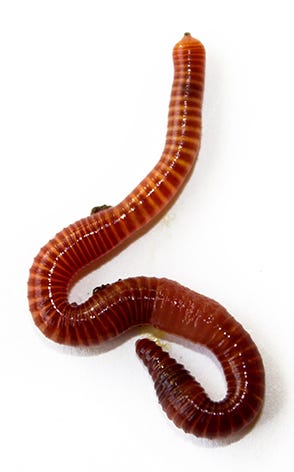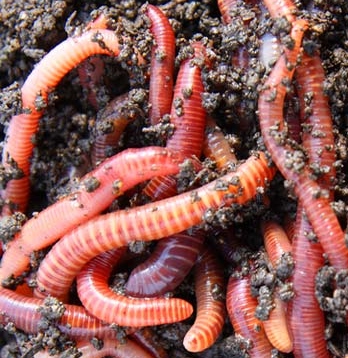Composting-perfect red wigglers: Use them to reduce waste
Composting-perfect red wigglers: Use them to reduce waste
Blog Article
The Duty of Red Wigglers in Lasting Gardening
The assimilation of red wigglers right into lasting gardening practices offers a compelling method to enhancing soil health and wellness and lowering organic waste. The implications of using red wigglers expand past mere composting; their role in forming an extra lasting future warrants a deeper expedition of their benefits and useful applications.
Comprehending Red Wigglers
Red wigglers, medically called Eisenia fetida, are a types of earthworm renowned for their function in lasting gardening and composting methods - red wigglers. These worms grow in breaking down raw material, making them particularly efficient in transforming kitchen area scraps and lawn waste into nutrient-rich garden compost. Unlike traditional earthworms, red wigglers have a greater resistance for varying wetness levels and can prosper in settings with plentiful organic product
(red wigglers for sale)Classically, red wigglers are smaller sized than their earthworm counterparts, usually gauging between 3 to 4 inches in length. They possess a reddish-brown coloration and have a segmented body framework that helps in their burrowing and feeding tasks. These organisms are hermaphroditic, indicating each specific possesses both male and women reproductive body organs, which permits reliable populace development under optimal problems.
The environment preferences of red wigglers include moist, dark atmospheres abundant in organic web content, such as garden compost containers or worm ranches. Their ecological duty prolongs past composting; they are indispensable in freshening the dirt and helping with nutrient biking, which inevitably adds to healthier garden environments. red wigglers. Understanding the biology and actions of red wigglers is vital for those seeking to apply effective vermicomposting in sustainable horticulture
Advantages of Vermicomposting
Vermicomposting deals countless benefits that enhance lasting gardening practices and add to ecological wellness. Among the main benefits is the transformation of natural waste right into nutrient-rich compost, which improves dirt framework and fertility. The castings created by red wigglers are loaded with helpful bacteria and crucial nutrients, making them an outstanding natural plant food.
Additionally, vermicomposting significantly lowers land fill waste. By diverting cooking area scraps and lawn waste from land fills, this practice not only reduces methane emissions-- a potent greenhouse gas-- yet likewise promotes a round economic climate, where waste is repurposed as a source.
An additional advantage is the improvement of dirt oygenation and drainage (red wigglers). The burrowing activity of red wigglers develops channels in the dirt, permitting air and water to pass through more conveniently, therefore fostering a much healthier root system for plants
In addition, vermicomposting can be done on a small range, making it easily accessible for city garden enthusiasts and those with limited area. This approach urges environmental stewardship and recognition, as people become extra involved with their waste administration methods. Inevitably, vermicomposting represents a lasting, reliable, and green strategy to gardening that profits both plants and the earth.
How to Start Vermicomposting
Beginning your own vermicomposting system can be a gratifying venture that boosts your lasting gardening methods. To Our site start, choose a proper container, such as a plastic container or wood box, with great drainage and air flow. The size will certainly depend upon the quantity of kitchen scraps you generate; a container of 10-14 gallons normally is adequate for a household.
Next, prepare the bed linen material. Shredded newspaper, cardboard, and coconut coir are excellent options, providing a comfortable habitat for the red wigglers. Go for a bedding depth of concerning 4-6 inches, which should be damp however not soggy.
When the bed linens is developed, present your worms. Red wigglers (Eisenia fetida) are one of the most appropriate for composting. Start with about one pound of worms for every 2-3 extra pounds of kitchen scraps weekly.
Begin adding kitchen area waste, avoiding meat, milk, and oily foods, as these can attract parasites and create smells. Regularly keep track of the container's wetness levels and temperature level, ensuring it stays within the optimal variety for worm activity. With these preliminary actions, you'll be well on your means to producing nutrient-rich compost for your garden.
Maintaining a Healthy And Balanced Worm Bin
A prospering worm container requires constant care and focus to maintain an optimal environment for the red wigglers. Trick factors to monitor consist of wetness levels, temperature level, and food supply. Maintaining a moisture degree comparable to a wrung-out sponge is vital; excessive water can bring about anaerobic problems, while too little can dehydrate the worms.
Temperature level is likewise vital, as red wigglers flourish in a variety of 55 to 77 degrees Fahrenheit. Extreme temperature levels can worry the worms, possibly causing death. Putting the bin in a climate-controlled location or using protecting materials can assist control temperature fluctuations.

Last but not least, aeration is vital. On a regular basis transforming the bed linens and making use of a fork or shovel can protect against compaction and advertise airflow, making sure a healthy, successful environment for the red wigglers. By sticking to these practices, garden enthusiasts can preserve an efficient worm bin that sustains lasting horticulture efforts.
Influence On Soil Health
Enhancing soil health with using red wigglers is a basic facet of lasting gardening. These worms, recognized medically as Eisenia fetida, play an essential function in boosting dirt structure and fertility. By consuming raw material, red wigglers break down complicated products into less complex substances, a process recognized as vermicomposting. The end product, worm castings, is abundant in essential nutrients, consisting of nitrogen, phosphorus, and potassium, which are vital for plant development.

(red wiggler worms for sale)Researches have shown that dirts enriched with worm castings show boosted microbial activity and boosted fertility, resulting in greater crop returns. By including red wigglers right into horticulture practices, garden enthusiasts not just enhance their soil but additionally add to an extra sustainable agricultural system, emphasizing the interconnectedness of soil wellness and environmental stewardship.

Verdict
In final thought, red wigglers substantially contribute to lasting gardening through their reliable vermicomposting methods. Their capacity to transform natural waste into nutrient-rich compost improves dirt fertility and supports a diverse microbial ecological community. Their burrowing task enhances soil oygenation and water retention, profiting plant health. By promoting waste reduction and fostering a round economy, red wigglers emerge as necessary components in environmentally friendly horticulture campaigns, underscoring their vital function in environmental sustainability.
Report this page